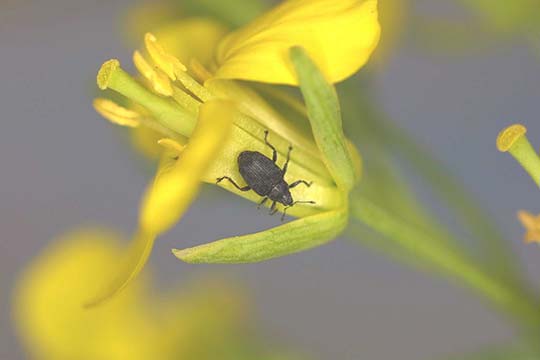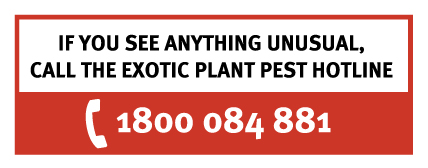



Cabbage seedpod weevil (Ceutorhynchus obstrictus) is a major pest of canola production overseas and will also feed on other Brassica crops, such as mustards, cabbage and broccoli. Feeding of both the larvae and adult life stages causes crop damage.
The highest levels of damage occur through larvae feeding within developing pods. Each larva consumes up to five seeds before exiting the pod, resulting in a yield reduction of up to 40%. Premature shattering of damaged pods can also occur.
Adults are approximately 3 mm in length with a matt grey body and greyish-black legs. They have a distinctive long, downward-curved weevil snout (rostrum), which can be held on the underside of the body. On the wing covers there are usually two rows of whitish hairs in furrows near the mid-line, giving the appearance of white lines.
Larvae are creamy white with a yellow-brown head and are legless. They grow to approximately 5 mm in length and at maturity leave exit holes in seed pods. Pupation occurs in the soil.
Both the adult and larvae can be confused with other weevils that attack canola, such as the vegetable weevil. The cabbage seedpod weevil can be distinguished from these weevils by its small size and elongated downward-curved snout (adult) and where the larva feed (inside pods).
Lightened flecks develop on the outside of the pod following larvae feeding on the seeds. On mature pods, pinhead sized exit holes surrounded by a discoloured area are visible.
Adults may be seen feeding on the flowers, stem, buds and developing pods. When adults feed on the buds, bud-blasting (potentially reducing yield in dry years) can occur. Adult feeding can also reduce oil content, seed weight and seed germination.
Medium length pods (20-40 mm long) are preferred by females for egg laying. They bore a hole through the pod wall with their snout and insert an egg into the pod.
Adults are strong fliers and can spread throughout and between crops naturally, particularly during flowering through to pod-set. Due to their small size, flight during windy periods can carry them over large distances. Various life stages have the potential to spread with soil and plant material.
Cabbage seedpod weevil is considered native to Europe and has been recorded in Canada and USA.
Check your canola crops frequently (a sweep net can be used), particularly during flowering until pod set. The earliest flowering canola crops are at highest risk and should be monitored more closely.
Make sure you are familiar with common pests of canola so you can tell if you see something different.
If you see anything unusual, call the Exotic Plant Pest Hotline on 1800 084 881.

Cabbage seedpod weevil (Ceutorhynchus obstrictus) is a major pest of canola production overseas and will also feed on other Brassica crops, such as mustards, cabbage and broccoli. Feeding of both the larvae and adult life stages causes crop damage.
The highest levels of damage occur through larvae feeding within developing pods. Each larva consumes up to five seeds before exiting the pod, resulting in a yield reduction of up to 40%. Premature shattering of damaged pods can also occur.
Adults are approximately 3 mm in length with a matt grey body and greyish-black legs. They have a distinctive long, downward-curved weevil snout (rostrum), which can be held on the underside of the body. On the wing covers there are usually two rows of whitish hairs in furrows near the mid-line, giving the appearance of white lines.
Larvae are creamy white with a yellow-brown head and are legless. They grow to approximately 5 mm in length and at maturity leave exit holes in seed pods. Pupation occurs in the soil.
Both the adult and larvae can be confused with other weevils that attack canola, such as the vegetable weevil. The cabbage seedpod weevil can be distinguished from these weevils by its small size and elongated downward-curved snout (adult) and where the larva feed (inside pods).
Lightened flecks develop on the outside of the pod following larvae feeding on the seeds. On mature pods, pinhead sized exit holes surrounded by a discoloured area are visible.
Adults may be seen feeding on the flowers, stem, buds and developing pods. When adults feed on the buds, bud-blasting (potentially reducing yield in dry years) can occur. Adult feeding can also reduce oil content, seed weight and seed germination.
Medium length pods (20-40 mm long) are preferred by females for egg laying. They bore a hole through the pod wall with their snout and insert an egg into the pod.
Adults are strong fliers and can spread throughout and between crops naturally, particularly during flowering through to pod-set. Due to their small size, flight during windy periods can carry them over large distances. Various life stages have the potential to spread with soil and plant material.
Cabbage seedpod weevil is considered native to Europe and has been recorded in Canada and USA.

Check your canola crops frequently (a sweep net can be used), particularly during flowering until pod set. The earliest flowering canola crops are at highest risk and should be monitored more closely.
Make sure you are familiar with common pests of canola so you can tell if you see something different.
If you see anything unusual, call the Exotic Plant Pest Hotline on 1800 084 881.